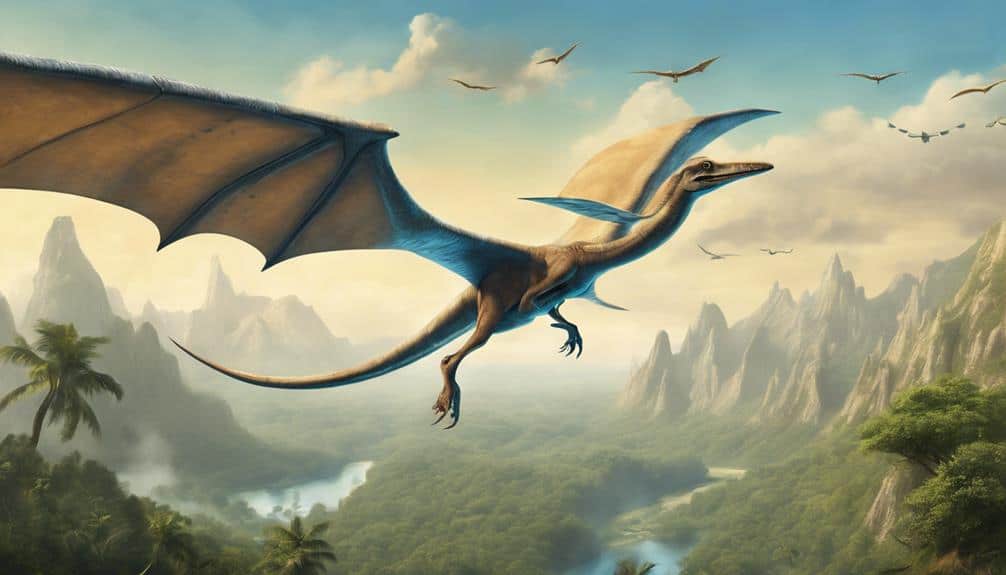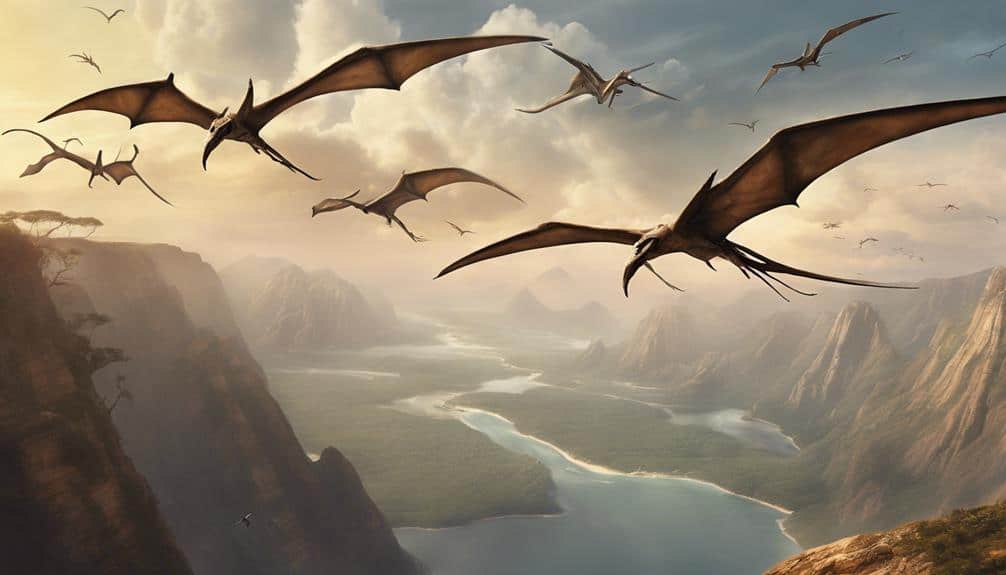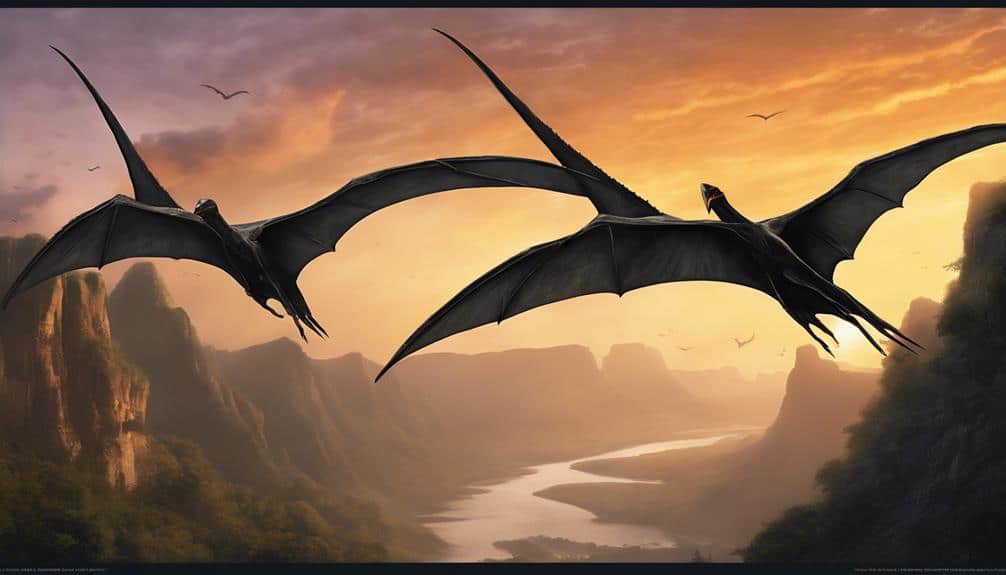How Big Were Pterosaurs? Imagine the skies of the Mesozoic era, teeming with Pterosaurs, from the tiny Nemicolopterus to the colossal Quetzalcoatlus. These ancient reptiles, adorned with wingspans that could stretch wider than a city bus, present a fascinating glimpse into prehistoric aviation. This introduction invites you to soar through time, exploring the astonishing scale of these creatures.

How Big Were Pterosaurs?
Yes, Pterosaurs varied significantly in size. The smallest known species had a wingspan of about 250 millimeters, akin to a sparrow, while the largest, such as Quetzalcoatlus, boasted wingspans exceeding 10 meters, rivaling that of a small aircraft. This vast range highlights the incredible diversity and adaptability of these ancient aviators.
Pterosaurs, the first vertebrates to achieve flight, captivated the skies of the Mesozoic Era with a range of sizes, from modest to the largest pterosaurs had wingspans exceeding 9m, comparable to small airplanes’ wingspans. These magnificent creatures adapted for hunting on land, showcasing the diversity of their feeding habits and ecological roles. The skin stretched from their elongated fourth finger to their hind limbs, forming a wing structure that was both robust and flexible, allowing for impressive aerial maneuvers.
High atmospheric oxygen levels during their reign possibly contributed to their colossal sizes and the flight implications included higher wing loadings, indicating a more energy-intensive flight compared to modern birds and bats.
Fossil evidence and advanced imaging techniques have refined pterosaur size estimates, revealing that these creatures exhibited a sophisticated array of adaptations for flight. Their bones were hollow and air-filled, reducing weight while maintaining strength, a trait also observed in modern birds. Flight in these ancient reptiles included aspects not only of gliding but also of powered flight, with muscle attachments and wing shapes suggesting a highly active lifestyle.
The discovery of pterosaurs with skin stretched from limb to limb, alongside detailed fossil evidence and comparisons with modern birds and bats, has shed light on the evolution of vertebrate flight. These findings underscore the importance of pterosaurs in understanding how flight evolved and the ecological niches they occupied, from the skies of the Mesozoic Era to the impacts their existence has on our understanding of prehistoric life.
Table of Contents
Key Takeaways
- Pterosaurs varied in size, from as small as 25 centimeters to a wingspan of 10-11 meters.
- Some pterosaurs were as tall as modern giraffes when standing.
- The size range of pterosaurs included tiny anurognathids to giant species like Quetzalcoatlus.
- Larger pterosaurs had powerful flight muscles and efficient respiratory systems for sustained flight.
As we embark on this journey, we’ll uncover the secrets behind the survival and evolutionary success of Pterosaurs. From the delicate balance of their massive wings to the aerodynamic prowess that allowed them to rule the skies, these creatures offer a unique perspective on life millions of years ago. Stay with me as we explore the fascinating world of Pterosaurs, their sizes, and the intriguing roles they played in their ecosystems.
Pterosaur Size Diversity: Evolutionary Adaptations Across Mesozoic Skies
Pterosaur size diversity, spanning from the diminutive Nemicolopterus to the colossal Quetzalcoatlus, underscores the remarkable evolutionary adaptations these creatures underwent to conquer Mesozoic skies. These variations in size and corresponding anatomical modifications facilitated a wide range of flight capabilities and ecological niches.
This diversity not only reflects the evolutionary pressures of their environments but also highlights the pterosaurs‘ role as a dominant aerial predator and scavenger throughout the Mesozoic era.
Evolutionary Size Range
The evolutionary journey of pterosaurs demonstrates a significant diversity in body size.
Nemicolopterus possesses a wingspan of 250 mm. This small size classifies Nemicolopterus as a small insectivore.
In contrast, Quetzalcoatlus boasts a wingspan greater than 30 feet. This large size enables Quetzalcoatlus to function as a predator of large prey.
Angustinaripterus, with a moderate wingspan, remains less understood in terms of specific adaptation.
Thapunngaka shawi exhibits a large wingspan, indicating its role as a specialized hunter.
Dearc, characterized by a very large wingspan, is adapted for long flight.
These examples underscore the evolutionary adaptations of pterosaurs, showcasing their adaptability and diversity throughout the Mesozoic era.
Adaptations for Flight

The diverse adaptations for flight exhibited by pterosaurs highlight their evolutionary ingenuity, enabling them to dominate Mesozoic skies with varying body sizes and wing spans. These ancient reptiles evolved a series of remarkable features to master the air:
- An elongated fourth finger supported the wings of pterosaurs, allowing for extensive wing surfaces.
- Hollow, air-filled bones reduced the overall weight of pterosaurs, making flight more energy-efficient.
- Air sacs were part of a highly efficient respiratory system in pterosaurs, extending into the neck, trunk, and wings to facilitate oxygen exchange and aid buoyancy in flight.
- The pteroid bone, a specialized bone in pterosaurs, controlled the wing’s leading edge for better maneuverability and control during flight.
These features, from skeletal adaptations to the advanced respiratory system including air sacs, underscore the pterosaurs‘ evolutionary mastery of flight.
Largest Pterosaurs Unveiled: Colossal Wingspans Meeting Peak Aerodynamics
The exploration of the largest pterosaurs reveals creatures with wingspans exceeding 9 meters, a confirmation of remarkable evolutionary achievements in aerodynamics and physical adaptation.
These giants, such as Quetzalcoatlus, combined substantial body masses up to 250 kilograms with flight capabilities enhanced by the Mesozoic era’s environmental conditions.
This segment will examine the anatomical and physiological traits that enabled these pterosaurs to navigate ancient skies efficiently, focusing on their skeletal strength, wing membrane structures, and metabolic systems supporting sustained flight.
Gigantic Flyers’ Anatomy
Pterosaurs, the prehistoric sky giants, had wingspans that could surpass 10 meters. Their unique anatomical framework was optimized for peak aerodynamic performance. These creatures were among the largest animals to have ever achieved flight. They integrated remarkable biological adaptations to dominate the skies.
Their skeletal system displayed pneumaticity, characterized by hollow, thin-walled bones. This feature made them lighter and more agile for aerial maneuvers. A specialized respiratory system was another adaptation, which included air sacs. These air sacs extended into the neck, trunk, and wings. This system facilitated a high-energy flight regime by enabling efficient oxygen exchange.
The table below outlines the features and functions related to their flight capabilities:
- Skeletal Pneumaticity significantly reduced their weight, aiding in flight.
- The structure of the Wing Membrane allowed for efficient flight capabilities.
- The Pteroid Bone played a crucial role in controlling the wing’s leading edge.
- Respiratory Air Sacs greatly enhanced oxygen exchange, supporting sustained flight.
These adaptations allowed pterosaur flight to evolve beyond mere gliding. They were capable of performing dynamic aerial feats, showcasing the remarkable engineering of their anatomy.
Quetzalcoatlus: A Sky Giant: Staggering Altitudes With Prehistoric Grace

Quetzalcoatlus, with its gargantuan wingspan exceeding 40 feet, represents the pinnacle of pterosaur evolution, showcasing remarkable adaptations for flight despite its massive size.
This section explores the biomechanical complexities and aerodynamic efficiencies that enabled such a large creature to achieve flight and maintain considerable altitudes.
Through an examination of its skeletal structure and flight musculature, we gain insights into the evolutionary marvels that allowed Quetzalcoatlus to traverse prehistoric skies with grace and agility.
Unmatched Aerial Size
In prehistoric times, Quetzalcoatlus stood out among the giants of the sky. This pterosaur had a wingspan that rivaled that of modern aircraft.
Quetzalcoatlus represents the apex of aerial evolution among pterosaurs. Pterosaur fossils have revealed that Quetzalcoatlus was the largest flying animal ever discovered. The wingspan of Quetzalcoatlus measured between 33 and 36 feet. Quetzalcoatlus could weigh up to 250 kilograms.
This creature lived during the Late Cretaceous era. Quetzalcoatlus likely hunted small dinosaurs on land. These characteristics demonstrate the unmatched aerial size of Quetzalcoatlus, highlighting it as an evolutionary marvel that soared through prehistoric skies with incredible grace and altitude.
Flight Mechanics Explained
Quetzalcoatlus showcased flight capabilities efficiently despite its size. Wing loadings of Quetzalcoatlus were higher than those of modern birds. This feature allowed for efficient soaring and adept terrestrial hunting.
Adaptations in Quetzalcoatlus resembled those in modern bats. Air sacs within wing membranes supported flight in Quetzalcoatlus. A quadrupedal launch stance was used by Quetzalcoatlus for initial takeoff momentum.
Thermal soaring abilities in Quetzalcoatlus were limited. However, strategic gliding and environmental exploitation enabled sustained flights. These mechanisms allowed Quetzalcoatlus to master flight with prehistoric grace.
Pterodactyl and Pteranodon Compared: Morphological Nuances Amid Pterosaur Kin

The comparative analysis of Pterodactyl and Pteranodon within the pterosaur family illuminates significant morphological distinctions and evolutionary adaptations. These differences are not only pivotal in understanding their ecological niches but also underscore the diversity within the Pterosauria clade.
Key areas of comparison include:
- Wing span variations
- Dietary preferences and feeding mechanisms
- Habitat distribution and geographical range
- Skeletal and muscular adaptations for flight
Wing Span Differences
Pterodactyls exhibited wingspans ranging from 1 meter to 3 meters. Their relatives, pteranodons, displayed considerably larger wingspans, typically exceeding 7 meters. This difference indicates significant morphological diversity within the pterosaur lineage.
The variation in wingspan highlights the adaptability and evolutionary success of pterosaur species. Their ability to occupy various ecological niches is showcased by this size diversity. Paleontologists gain insight into the flight adaptations and lifestyles of these ancient creatures through understanding these differences.
The complexity of pterosaur evolution is illustrated by these findings.
Anatomy of Flight in Pterosaurs: Muscular Power Coupled with Wing Evolution
The exceptional ability of pterosaurs to achieve powered flight can be attributed to significant anatomical adaptations, particularly in their wing structure and muscular strength.
Innovations such as the unique pteroid bone and specialized wing membranes facilitated precise control and maneuverability, while their muscular system, significantly around the chest and wings, provided the necessary power for sustained flight.
These evolutionary advancements underscore the complexity of pterosaur flight mechanics, revealing a sophisticated interplay between physical structure and aerodynamic efficiency.
Wing Structure Innovation
In delving into the anatomy of flight in pterosaurs, one learns that the wing structure innovation, particularly the inclusion of a pteroid bone, significantly contributed to their flight control. The pteroid bone allowed for precise control of the wing‘s leading edge.
Additionally, their skeletal structure was characteristically pneumatic, which considerably lessened their weight, enhancing their flight capabilities. The wing membrane provided the pterosaurs with the ability to engage in powered flight. Furthermore, air sacs facilitated efficient breathing while they were in flight.
The presence of an elongated fourth finger played a critical role in supporting the wing structure, enabling flight.
These adaptations were crucial for the pterosaurs‘ mastery of the skies, highlighting their evolutionary triumph as flying reptiles.
Muscular Strength Adaptations
- Pterosaurs developed specialized muscles for flight.
- These muscles provided the force necessary for taking off.
- The muscles also sustained flight in large specimens.
- Wing innovation and muscular adaptations allowed for efficient flight.
- Muscular strength enabled Pterosaurs to capture prey in flight.
The Mystery of Pterosaur Flight: Soaring Capabilities Amidst Evolutionary Enigmas
The evolution of flight mechanics in pterosaurs presents a complex interplay between anatomical adaptations and aerodynamic constraints, underpinning their diverse soaring capabilities.
Comparative analyses of fossilized remains with contemporary flying animals have shed light on the unique flight dynamics that characterized these Mesozoic era avians.
This exploration into the evolutionary enigmas of pterosaur flight aims to elucidate the biomechanical innovations that facilitated their aerial prowess across varied ecological niches.
Evolution of Flight Mechanics
Exploring the evolutionary puzzle of pterosaur flight mechanics demonstrates an adaptation: pterosaurs developed a wing structure. This wing structure is comparable to bats and enabled pterosaurs to navigate the Mesozoic skies efficiently. The adaptation highlights the complex evolution of flight mechanics through several key features:
- Pterosaurs possessed membrane wings. These membrane wings were supported by elongated fingers, contributing to dynamic flight capabilities.
- A specialized bone, known as the pteroid bone, existed in Pterosaurs. This bone controlled the wing’s leading edge, which was critical for maneuverability and stability in the air.
- Pterosaurs had an advanced respiratory system. This system incorporated air sacs, which enhanced oxygen efficiency during flight.
- Pterosaurs exhibited skeletal pneumaticity. Their bones were hollow and thin-walled, which reduced weight without compromising strength, thus facilitating sustained flight and aerial agility.
Frequently Asked Questions
How Big Was the Largest Flying Dinosaur?
The largest flying “dinosaur,” Quetzalcoatlus, was not actually a dinosaur but a pterosaur, boasting an impressive wingspan of approximately 33-36 feet and weighing up to 250 kilograms, highlighting its significant size among prehistoric avians.
How Tall Was the Pterosaurs?
Pterosaurs exhibited a wide range of heights, from a few inches to over 10 feet tall, primarily determined by species-specific leg lengths and body structures, adapting them to diverse ecological roles and flight capabilities.
Were Pterodactyls Bigger Than Planes?
Pterodactyls, a subset of pterosaurs, were not larger than airplanes. Their wingspans typically ranged from 1 to 10 meters, considerably smaller than the largest pterosaurs, which could reach wingspans exceeding 9 meters.
What Was the Wingspan of a Pterosaurs?
Pterosaurs exhibited a remarkable range of wingspans, from as small as 250 mm in species like Nemicolopterus to over 10 meters in giants such as Quetzalcoatlus, highlighting their diverse ecological adaptations and flight capabilities.
